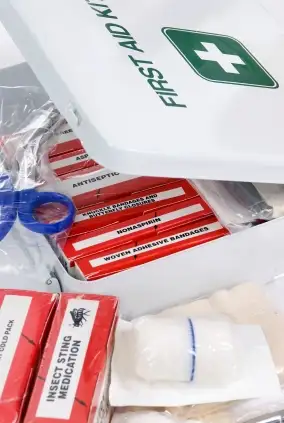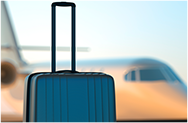
I always bring a small medical kit when traveling overseas, which has, on a number of occasions, helped me keep minor medical maladies from becoming major disasters. I’ve done a lot of research about the best medical items to bring, and road-tested many of them. What you’ll want to pack depends on where you’re going and your health issues, but here’s a basic list:
- Containers of liquid iodine and anti-bacteria ointment for cleaning wounds and preventing infection. I don’t buy individually wrapped wipes because I find they’re only useful for the most minor cuts.
- Pepto-Bismol tablets to ward off indigestion and Imodium A-D for when the Pepto just isn’t cutting it.
- Band-aids for small wounds and gauze pads and a small roll of medical tape for larger wounds. I also take moleskin for blisters.
- Over-the-counter pain medicine.
- Antihistamine—even if you have no allergies at home, you may be allergic to exotic plants and animals on your trip.
- A tiny bottle of eye drops for dry or dusty locales.
- Fine-point tweezers for removing splinters and a small set of scissors for cutting tape and bandages.
- Iodine tablets to purify water.
- A pair of surgical gloves for whoever is called upon to play doctor.
- A few doses of Ciprofloxacin (Cipro), a heavy-duty antibiotic used to treat everything from dysentery to anthrax. You need a prescription for this one—my doctor gives me one for trips to third-world or tropical destinations.
Add to this list your prescription medicines and whatever specialty items you might need.
Have a great travel tip you’d like to share? Send your insider travel strategies to [email protected].
We hand-pick everything we recommend and select items through testing and reviews. Some products are sent to us free of charge with no incentive to offer a favorable review. We offer our unbiased opinions and do not accept compensation to review products. All items are in stock and prices are accurate at the time of publication. If you buy something through our links, we may earn a commission.
Related
Top Fares From
Today's Top Travel Deals
Brought to you by ShermansTravel
12-Night Peru Escorted Tour, Incl. Sacred...
Wingbuddy
 vacation
$2198+
vacation
$2198+
Amsterdam to Copenhagen: Luxe, 18-Night Northern...
Regent Seven Seas Cruises
 cruise
$12399+
cruise
$12399+
Ohio: Daily Car Rentals from Cincinnati
85OFF.com
 Car Rental
$19+
Car Rental
$19+



